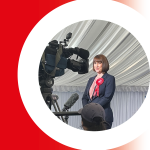
Prof David Deacon
Professor of Communication and Media Analysis, Centre for Research in Communication and Culture, Loughborough University.
Dr Jilly Kay
Senior Lecturer in Communication and Media at Loughborough University
Dr Brendan Lawson
Lecturer in Communication and Media at Loughborough University.
Dr Nathan Ritchie
Sociology teacher at Loughborough University.
Dr David Smith
Lecturer in Media and Communication, University of Leicester.
Prof Dominic Wring
Professor of Political Communication, Centre for Research in Communication and Culture, Loughborough University.

UK Election 2024
Section 7: News and journalism
73. Why the press still matters (Prof Steven Barnett)
74. When the Star aligned: how the press ‘voted’ (Prof Dominic Wring, Prof David Deacon)
75. Visual depictions of leaders and losers in the (still influential) print press (Prof Erik Bucy)
76. Towards more assertive impartiality? Fact-checking on BBC television news (Prof Stephen Cushion)
77. The outsize influence of the conservative press in election campaigns (Prof Dan Stevens, Prof Susan Banducci, Prof Ekaterina Kolpinskaya and Dr Laszlo Horvath)
78. GB News – not breaking any rules… (Prof Ivor Gaber)
79. Vogue’s stylish relationship to politics (Dr Chrysi Dagoula)
80. Tiptoeing around immigration has tangible consequences (Dr Maria Kyriakidou, Dr Iñaki Garcia-Blanco)
81. A Taxing Campaign (Prof David Deacon et al)
82. Not the Sun wot won it: what Murdoch’s half-hearted, last-minute endorsements mean for Labour (Dr John Jewell)
83. Is this the first podcast election? (Carl Hartley, Prof Stephen Coleman)
84. A numbers game (Prof Paul Bradshaw)
85. Election 2024 and the remarkable absence of media in a mediated spectacle (Prof Lee Edwards)
86. 2024: the great election turn-off (Prof Des Freedman)
This was a taxing General Election for journalists in two respects.
First, our General Election news audit shows that ‘tax and taxation’ dominated the substantive policy agenda in news reporting of the campaign. By comparison, the culture wars flickered but didn’t catch fire. Brexit remained in its box. Immigration emerged then disappeared. And many of the topics that polls consistently indicate to be of greater public concern – such as, the NHS, housing, climate change, social care – received far lower levels of media attention. By this measure, this might be deemed a media election fought within the preferred parameters of the Conservative party.
Second, journalists found it taxing to sustain interest in a horse race where the front runner seemed such a racing cert. One editorial response was to speculate extensively about the scale of the anticipated Labour victory, or to search for psephological signs of any dial shifting, particularly after Nigel Farage’s shock announcement that he was going to stand for Reform. Opinion pollsters certainly had a good media campaign, being featured far more frequently than in previous elections. Opinion poll findings and other ‘horse race’ speculation was very prominent in the ‘process’ coverage that typically dominated a lot of electoral reporting.
Another editorial response was to seize upon any gaffes, missteps, and controversies that occurred. And there were rich pickings in this election. Reform found itself on the sharp end of journalistic scrutiny in the latter stages as the repellent racism of several party candidates and activists was exposed. But the evident discomfort and displeasure this created for Farage paled by comparison to the editorial travails confronted by the Conservatives. Mistakes always have a media cut-through in election reporting and the Tory campaign had more bad optics than a derelict cocktail bar. The most news-worthy were the allegations about Conservative insiders betting on the timing of the election and the Prime Minister’s decision to stand up D-Day veterans and international leaders to keep a longstanding date with ITV News.
In any media election, the meta-coverage matters and this is where the Conservatives’ campaign fell apart. For lengthy periods of time they couldn’t even get on message let alone stay on message.
Inevitably, the ‘foregone conclusion-ness’ of the election led to a degree of editorial disengagement. In the last 25 weekdays of the election, 44% of the main stories on the BBC News at Ten were not about the General Election. The equivalent figures for other main broadcast programmes were: ITV News at Ten (28%), C4 (20%), C5 (68%), and Sky (44%).
In terms of news presence, our research shows that the 2024 media campaign was slightly more dominated by the two main parties and slightly less presidential than the previous General Election. Conservatives and Labour sources accounted for 66% of all political party appearances on the main TV news bulletins and 85% in the national weekly press (in both cases up 2% for our equivalent measures of GE2019). Party leaders overall commanded 52 percent of TV appearances (down 7% from 2019) and 39% of press appearances (down 3% from 2019).
The most significant difference in this election was how the remaining scraps of coverage were divided between the other parties. The two party squeeze is always most evident in national press coverage, but even in TV news, several of the other parties found themselves on thinner rations than before. Ed Davey may have been deemed to have had a good campaign but it didn’t prevent a reduction in the Liberal Democrats’ media presence (frequency of TV appearances down from 7.8% to 4.5%, quotation time down from 13.4% to 8% of all politician speaking time). The SNP were also more marginalised: down to 4.7% of TV appearances from 7.3% in GE2019. In contrast, Reform UK gained markedly more media exposure than their predecessor, the Brexit Party. Whereas in GE2019 the Brexit Party accounted for 7% of party appearances on TV and 5% in the press, these figures respectively increased to 10% for TV and 9% for newspapers in 2024. Whatever the basis of Nigel Farage’s recent complaints about his party’s treatment at the hands of the mainstream news media, he can’t claim he was ignored.
Finally, this was, yet again, a ‘mansplaining’ election. That only 1 in 5 of the politicians featured in coverage were female could be deemed a product of the male dominance of main party leaderships. But male voices had similar preponderance when representing the interests of business (82% of relevant sources), academia (72%) public professionals (70%), trade unions (74%), and think tanks (67%). Here again, we see a consistent privileging of male voices and it shows that gender disparity in news reporting is not just a reflection of inequalities in our political representation.
The CRCC’s analysis of the 2024 Campaign can be found at: https://www.lboro.ac.uk/news-events/general-election/
